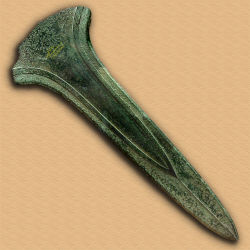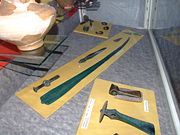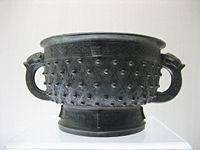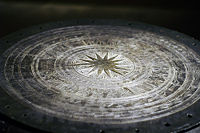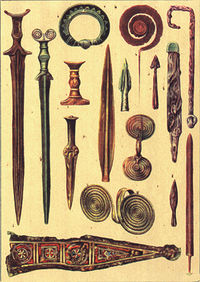Bronze Age
2008/9 Schools Wikipedia Selection. Related subjects: Ancient History, Classical History and Mythology
| Bronze Age |
|---|
| ↑ Neolithic |
|
Near East (3300-1200 BC)
India (3000-1200 BC) Europe (2300-600 BC)
China (2000-700 BC) Korea (800-400 BC) |
|
arsenical bronze |
| ↓Iron age |
The term Bronze Age refers to a period in human cultural development when the most advanced metalworking (at least in systematic and widespread use) included techniques for smelting copper and tin from naturally-occurring outcroppings of copper ores, and then smelting those ores to cast bronze. These naturally-occurring ores typically included arsenic as a common impurity. Copper/tin ores are rare, as reflected in the fact that there were no tin bronzes in western Asia before 3,000 B.C. The Bronze Age forms part of the three-age system for prehistoric societies. In this system, it follows the Neolithic in some areas of the world. On the other hand, in many parts of sub-Saharan Africa, the Neolithic is directly followed by the Iron Age. In some parts of the world, a Copper Age follows the Neolithic and precedes the Bronze Age.
Origins
The place and time of the invention of bronze are controversial and it is possible that bronzing was invented independently in multiple places. The earliest known tin bronzes are from what is now Iran and Iraq and date to the late 4th millennium BC. Arsenical bronzes were made in Anatolia and on both sides of the Caucasus by the early 3rd millennium BC. Some scholars date some arsenical bronze artifacts of the Maykop culture in the North Caucasus as far back as the mid 4th millennium BC, which would make them the oldest known bronzes, but others date the same Maykop artifacts to the mid 3rd millennium BC. Arsenic bronze however is a naturally occurring alloy, in contrary to the later used tin bronze. Tin had to be delved and smelted separately (mainly as the tin ore cassiterite), and added to the molten copper to make the alloy.
Near East
Periodization for the Bronze Age in the Ancient Near East is as follows:
| Bronze Age (3300 BCE - 1200 BCE) |
Early Bronze Age (3300 BCE - 2000 BCE) |
Early Bronze Age I | 3300 BCE - 3000 BCE |
| Early Bronze Age II | 3000 BCE - 2700 BCE | ||
| Early Bronze Age III | 2700 BCE - 2200 BCE | ||
| Early Bronze Age IV | 2200 BCE - 2000 BCE | ||
| Middle Bronze Age (2000 BCE - 1550 BCE) |
Middle Bronze Age I | 2000 BCE - 1750 BCE | |
| Middle Bronze Age II | 1750 BCE - 1650 BCE | ||
| Middle Bronze Age III | 1650 BCE - 1550 BCE | ||
| Late Bronze Age (1550 BCE - 1200 BCE) |
Late Bronze Age I | 1550 BCE - 1400 BCE | |
| Late Bronze Age II A | 1400 BCE - 1300 BCE | ||
| Late Bronze Age II B | 1300 BCE - 1200 BCE |
Mesopotamia
In Mesopotamia, the Bronze Age begins in the late Uruk period, spanning the Early Dynastic period of Sumer, the Akkadian Empire, the Old Babylonian and Old Assyrian periods and the period of Kassite hegemony.
Ancient Egypt
In Ancient Egypt, the Bronze Age begins in the Protodynastic period.
- Early Bronze Age
- Early Dynastic Period of Egypt
- Old Kingdom
- First Intermediate Period of Egypt
- Middle Bronze Age
- Middle Kingdom of Egypt
- Second Intermediate Period of Egypt ( Hyksos)
- Late Bronze Age
- New Kingdom
Levant
- Early Bronze Age
- Ebla
- Middle Bronze Age
- Amorites
- Late Bronze Age
- Mitanni
- Ugarit
- Aramaeans
Anatolia
- Hittite Empire
- Arzawa
- Assuwa
Aegean
The Aegean Bronze Age begins around 3000 BC when civilizations first established a far-ranging trade network. This network imported tin and charcoal to Cyprus, where copper was mined and alloyed with the tin to produce bronze. Bronze objects were then exported far and wide, and supported the trade. Isotopic analysis of the tin in some Mediterranean bronze objects indicates it came from as far away as Great Britain.
Knowledge of navigation was well developed at this time, and reached a peak of skill not exceeded until a method was discovered (or perhaps rediscovered) to determine longitude around 1750 AD, with the notable exception of the Polynesian sailors.
The Minoan civilization based from Knossos appears to have coordinated and defended its Bronze Age trade.
One crucial lack in this period was that modern methods of accounting were not available. Numerous authorities believe that ancient empires were prone to misvalue staples in favour of luxuries, and thereby perish by famines created by uneconomic trading.
Persian Plateau
- Elam
- Konar Sandal
- Kulli culture
- Tappeh Sialk
- BMAC
Collapse
How the Bronze Age ended in this region is still being studied. There is evidence that Mycenaean administration of the regional trade empire followed the decline of Minoan primacy. Evidence also exists that supports the assumption that several Minoan client states lost large portions of their respective populations to extreme famines and/or pestilence, which in turn would indicate that the trade network may have failed at some point, preventing the trade that would have previously relieved such famines and prevented some forms of illness (by nutrition). It is also known that the breadbasket of the Minoan empire, the area north of the Black Sea, also suddenly lost significant portions of its population, and thus probably some degree of cultivation in this era.
Recent research has discredited the theory that exhaustion of the Cypriot forests caused the end of the bronze trade. The Cypriot forests are known to have existed into later times, and experiments have shown that charcoal production on the scale necessary for the bronze production of the late Bronze Age would have exhausted them in less than fifty years.
One theory says that as iron tools became more common, the main justification of the tin trade ended, and that trade network ceased to function as it once did. The individual colonies of the Minoan empire then suffered drought, famine, war, or some combination of these three factors, and thus they had no access to the far-flung resources of an empire by which they could easily recover.
Another family of theories looks to Knossos itself. The Thera eruption occurred at this time, 110 kilometers (70 mi) north of Crete. Some authorities speculate that a tsunami from Thera destroyed Cretan cities. Others say that perhaps a tsunami destroyed the Cretan navy in its home harbour, which then lost crucial naval battles; so that in the LMIB/LMII event (c. 1450 BC) the cities of Crete burned and the Mycenaean civilization took over Knossos. If the eruption occurred in the late 17th century BC (as most chronologists now think), then its immediate effects belong to the Middle Bronze to Late Bronze Age transition, and not to the end of the Late Bronze Age; but it could have triggered the instability which led to the collapse first of Knossos and then of Bronze Age society overall. One such theory looks to the role of Cretan expertise in administering the empire, post-Thera. If this expertise was concentrated in Crete, then the Mycenaeans may have made crucial political and commercial mistakes when administering the Cretans' empire.
More recent archaeological findings, including on the island of Thera (more commonly known today as Santorini), suggest that the center of Minoan Civilization at the time of the eruption was actually on this island rather than on Crete. Some think that this was the fabled Atlantis (a map drawn on a wall of a Minoan palace in Crete depicts an island similar to that described by Plato and similar too to the form Thera very likely had prior to its explosion). According to this theory, the catastrophic loss of the political, administrative and economic centre by the eruption as well as the damage wrought by the tsunami to the coastal towns and villages of Crete precipitated the decline of the Minoans. A weakened political entity with a reduced economic and military capability and fabled riches would have then been more vulnerable to human predators. Indeed, the Santorini Eruption is usually dated to c. 1630 BC. And, the Mycenaean Greeks first enter the historical record a few decades later c. 1600 BC. Thus, the later Mycenaean assaults on Crete (c.1450 BC) and Troy (c.1250 BC) are revealed as but continuations of the steady encroachments of the Greeks upon the weakened Minoan world.
Each of these theories is persuasive, and aspects of all of them may have some validity in describing the end of the Bronze Age in this region.
Indus valley
The Bronze Age on the Indian subcontinent began around 3300 BCE with the beginning of the Indus Valley civilization. Inhabitants of the ancient Indus Valley, the Harappans, developed new techniques in metallurgy and produced copper, bronze, lead and tin. The Indian Bronze Age ends at the start of the Iron Age Vedic Period (1500 BCE - 500 BCE). This is during the Harappan culture, which dates from 1700 BCE to 1300 BCE, that overlaps the transition period between the Bronze Age, and the Iron Age period. As a result, it is difficult to pinpoint the true end of the Indian Bronze Age.
East Asia
China
Historians disagree about the dates that should be attached to a “Bronze Age” in China. The difficulty lies in the term “Bronze Age” itself, as it has been applied to signify a period in European and Middle Eastern history when bronze tools replaced stone tools, and were later replaced by iron ones. In those places, the medium of the new “Age” made that of the old obsolete. In China, however, any attempt to establish a definite set of dates for a Bronze Age is complicated by two factors: the early arrival of iron smelting technology and the persistence of bronze in tools, weapons and sacred vessels. The earliest bronze artifacts are found in the Majiayao culture site, and from then on the society gruadually grew into the Bronze Age
Bronze metallurgy in China originated in what is referred to as the Erlitou (also Erh-li-t’ou) period, which some historians argue places it within the range of dates controlled by the Shang dynasty. Others believe the Erlitou sites belong to the preceding Xia (also Hsia) dynasty. The U.S. National Gallery of Art defines the Chinese Bronze Age as the “period between about 2000 BC and 771 BC,” a period which begins with Erlitou culture and ends abruptly with the disintegration of Western Zhou rule. Though this provides a concise frame of reference, it overlooks the continued importance of bronze in Chinese metallurgy and culture. Since this is significantly later than the discovery of bronze in Mesopotamia, bronze technology could have been imported rather than discovered independently in China.
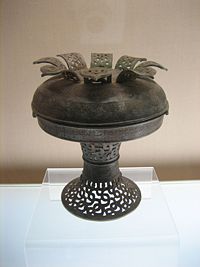
Iron is found in the Zhou period, but its use is minimal. Chinese literature dating to the 6th century BC attests a knowledge of iron smelting, possibly making iron a Chinese invention, yet bronze continues to occupy the seat of significance in the archaeological and historical record for some time after this. Historian W. C. White argues that iron did not supplant bronze “at any period before the end of the Zhou dynasty (481 BC)” and that bronze vessels make up the majority of metal vessels all the way through the Later Han period, or through 221 AD.
The Chinese bronze artifacts generally are either utilitarian, like spear points or adze heads, or ritualistic, like the numerous large sacrificial tripods. However, even some of the most utilitarian objects bear the markings of more sacred items. The Chinese inscribed all kinds of bronze items with three main motif types: demons, symbolic animals, and abstract symbols. Some large bronzes also bear inscriptions that have helped historians and archaeologists piece together the history of China, especially during the Zhou period.
The bronzes of the Western Zhou period document large portions of history not found in the extant texts, and often were composed by persons of varying rank and possibly even social class. Further, the medium of cast bronze lends the record they preserve a permanence not enjoyed by manuscripts. These inscriptions can commonly be subdivided into four parts: a reference to the date and place, the naming of the event commemorated, the list of gifts given to the artisan in exchange for the bronze, and a dedication. The relative points of reference these vessels provide have enabled historians to place most of the vessels within a certain time frame of the Western Zhou period, allowing them to trace the evolution of the vessels and the events they record.
Southeast Asia
In Ban Chiang, Thailand, ( Southeast Asia) bronze artifacts have been discovered dating to 2100 BC.
In Nyaunggan, Myanmar bronze tools have been excavated along with ceramics and stone artefacts. Dating is still currently broad (3500–500 BC).
Korean peninsula
The Middle Mumun pottery period culture of the southern Korean Peninsula gradually adopted bronze production (c. 700–600? BC) after a period when Liaoning-style bronze daggers and other bronze artifacts were exchanged as far as the interior part of the Southern Peninsula (c. 900–700 BC). The bronze daggers lent prestige and authority to the personages who wielded and were buried with them in high-status megalithic burials at south-coastal centres such as the Igeum-dong site. Bronze was an important element in ceremonies and as for mortuary offerings until 100.
Europe
Central Europe
In Central Europe, the early Bronze Age Unetice culture (1800–1600 BC) includes numerous smaller groups like the Straubing, Adlerberg and Hatvan cultures. Some very rich burials, such as the one located at Leubingen with grave gifts crafted from gold, point to an increase of social stratification already present in the Unetice culture. All in all, cemeteries of this period are rare and of small size. The Unetice culture is followed by the middle Bronze Age (1600–1200 BC) Tumulus culture, which is characterised by inhumation burials in tumuli (barrows). In the eastern Hungarian Körös tributaries, the early Bronze Age first saw the introduction of the Mako culture, followed by the Ottomany and Gyulavarsand cultures.
The late Bronze Age Urnfield culture, (1300–700 BC) is characterized by cremation burials. It includes the Lusatian culture in eastern Germany and Poland (1300–500 BC) that continues into the Iron Age. The Central European Bronze Age is followed by the Iron Age Hallstatt culture (700–450 BC).
Important sites include:
- Biskupin (Poland)
- Nebra (Germany)
- Vráble (Slovakia)
- Zug-Sumpf, Zug, Switzerland
Caucasus
Some scholars date some arsenical bronze artifacts of the Maykop culture in the North Caucasus as far back as the mid 4th millennium BC.
Great Britain
In Great Britain, the Bronze Age is considered to have been the period from around 2100 to 750 BC. Migration brought new people to the islands from the continent. Recent tooth enamel isotope research on bodies found in early Bronze Age graves around Stonehenge indicate that at least some of the migrants came from the area of modern Switzerland. The Beaker culture displayed different behaviours from the earlier Neolithic people and cultural change was significant. Integration is thought to have been peaceful as many of the early henge sites were seemingly adopted by the newcomers. The rich Wessex culture developed in southern Britain at this time. Additionally, the climate was deteriorating, where once the weather was warm and dry it became much wetter as the Bronze Age continued, forcing the population away from easily-defended sites in the hills and into the fertile valleys. Large livestock farms developed in the lowlands which appear to have contributed to economic growth and inspired increasing forest clearances. The Deverel-Rimbury culture began to emerge in the second half of the Middle Bronze Age (c. 1400–1100 BC) to exploit these conditions. Cornwall was a major source of tin for much of western Europe and copper was extracted from sites such as the Great Orme mine in northern Wales. Social groups appear to have been tribal but with growing complexity and hierarchies becoming apparent.
Also, the burial of dead (which until this period had usually been communal) became more individual. For example, whereas in the Neolithic a large chambered cairn or long barrow was used to house the dead, the Early Bronze Age saw people buried in individual barrows (also commonly known and marked on modern British Ordnance Survey maps as Tumuli), or sometimes in cists covered with cairns.
The greatest quantities of bronze objects found in England were discovered in East Cambridgeshire, where the most important finds were recovered in Isleham (more than 6500 pieces).
Ireland
The Bronze Age in Ireland commenced in the centuries around 2000 BC when copper was alloyed with tin and used to manufacture Ballybeg type flat axes and associated metalwork. The preceding period is known as the Copper Age and is characterised by the production of flat axes, daggers, halberds and awls in copper. The period is divided into three phases: Early Bronze Age (2000–1500 BC), Middle Bronze Age (1500–1200 BC), and Late Bronze Age (1200 – c. 500 BC). Ireland is also known for a relatively large number of Early Bronze Age burials.
One of the characteristic type of artifact of the Early Bronze Age in Ireland is the flat axe. There are five main types of flat axes: Lough Ravel (c. 2200 BC), Ballybeg (c. 2000 BC), Killaha (c. 2000 BC), Ballyvalley (c. 2000–1600 BC), Derryniggin (c. 1600 BC), and a number of metal ingots in the shape of axes.
